2 wonderful things have happened in the last few weeks – well 3 actually as we have 2 different papers accepted by 2 different journals! Firstly…. its finally managed to rain despite the BOM telling us repeatedly it won’t. Not all El nino years are droughts – the BOM likes to catastrophize – hottest! Coldest! Biggest flood ever! Driest on record! etc etc. Early cyclones are also not supposed to happen in El Nino years but tell that to those sheltering without power in FNQ atm. The weather is just too unpredictable for puny humans & that’s the way it’s always been – hence we created Gods. Gods to pray to & die for – it’s a human thing ….
Baiame first made man at Murula, a mountain between the Barwan and the Narran rivers. He formerly lived among men. And in the stony ridges between those two rivers there is a hole in the rock, shaped like a man, two or three times as large as a common man. In this, it is said, Baiame used to rest himself. He had a large tribe round him, whom he fed at a place called Midule. Suddenly he vanished from them, and went up to heaven. Still, though unseen, he provides them food, making the grass to grow for them. And they believe he will come back at a future time.
I heard of Baia-me from the Aborigines on the Namoi and Barwan. Many of them, when asked concerning any object, such as the river, trees, sun, stars, etc.,-who made these? uniformly and readily replied” Baiame.” And many of them have said to me in answer to questions about him,-as old King Rory of Gingi did in 1871,-” KamillJaia IJummi Baiame; lJaia winulJulda (I have not seen Baiame; I hear him).”
The milky way, as King Rory told me, is a worrumbul, (warrambool) or grove with a watercourse running through it, abounding in all pleasant things, where Baiame welcomes the good to a happy life, where they walk up and down in the enjoyment of peace and plenty. It is “the inside,” he said, that goes up to the sky-not the bones and flesh. Sometimes the good come down again to visit the earth. Colonists who have for many years observed the Aborigines, say that it is a common thing for these people, in the prospect of death, to express a cheerful hope of being better off hereafter.
(KAMILAROI, AND OTHER AUSTRALIAN LANGUAGES, BY REV. WILLIAM RIDLEY, 2ND ED. (SYDNEY, 1875) – PAGE 148)
The second exciting thing(s) is the publication & acceptance for publication of our TinT papers. I wrote a 5000+ word “short communication” for an internet publication called Plant signalling and behaviour published by Taylor & Francis Online. The editor, Prof. František Baluška, from the University of Bonn, Germany is the author of over 160 papers and founder of 2 scientific journals. He encouraged me to have a crack & explained what was expected. The normal charges were waived as I don’t have university backing or any funding at all. Citizen scientists of Oz must rely on the altruism and curiosity of foreign scholars/ publishers unfortunately.
Trees in trees a report from remote Australia, published in Plant Signaling & Behavior, Volume 18 Issue 1, is now available to access via tandfonline.com.
The main paper of which Jen Silcock is the author & I am a co-author has also been accepted for publication in the Australian journal of Botany. Other co-authors are Allan Tighe Rhonda Ashby Priscilla Reid Loynes & Russell Fairfax. The paper is titled ‘Unusual, human-mediated prevalence of epiphytes in semi-arid New South Wales, Australia’ & when it appears I will provide a link. I can’t make my links work by clicking on them so you may have to cut & paste & google them. Don’t be intimidated by the long scientific words in my paper’s ‘abstract’ – just google them too & activate your brain!
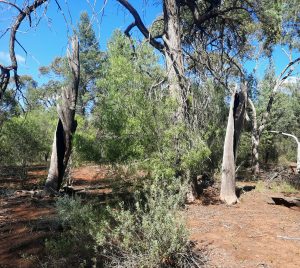
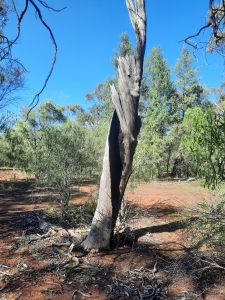
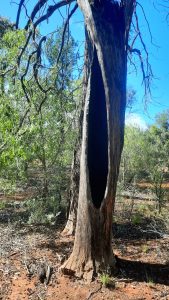
I’ve been poking around in the Ginghet reserve just off Billybingbone road recently and found some very interesting individually scorched trees. One of the culturally charred stumps contains another old emu bush guest and there is a couple of what seem to be burnt and twisted pines (above) How this Wailwun clan would have managed to burn only the interior of a twisted pine I have no idea? Cremation may have been needed to deal with bodies when the smallpox hit so perhaps thats what was happening here? This reserve has old tennis courts as well as a cricket oval on what appears to be a natural (or culturally conserved) clearing. High red sandy knobs near semi-permanent watercourses seem to be good places for clan camps and tennis.
A new host joined the TinT club in November & was never properly introduced. This gnarly old whitewood – birraa – Atalaya hemiglauca – has a currant bush growing out of the base.
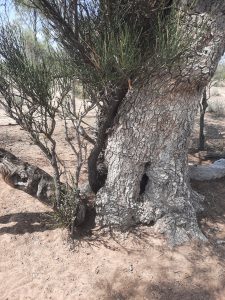
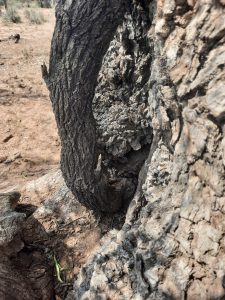
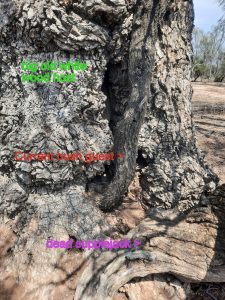
The currant bush guest is surrounded by smaller ones & is wedged in the whitewood by a dead supplejack. I’m noticing more of these multiple tree manipulations now like this crazy leopardwood lollipop.
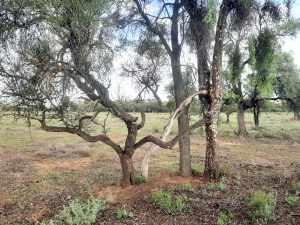
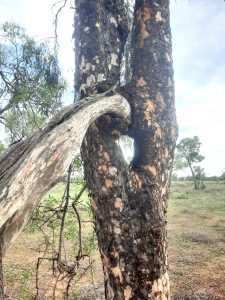
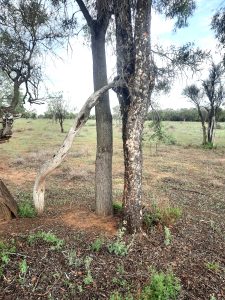
Again a currant bush is involved but this one is dead. The currant bush trunk has been placed in the leopardwood fork causing it to fuse at the junction creating a ring. Yes, I know it could have fallen in there, but no ground is disturbed at the currant bush base and no trunk end is poking out the other side of the leopardwood fork.
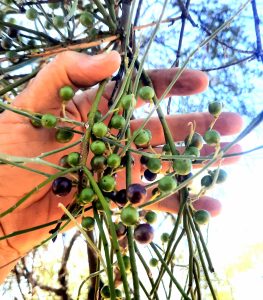
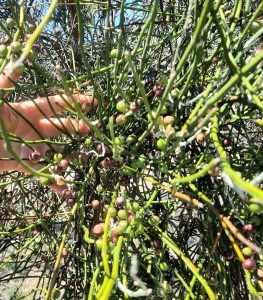
The currant bush is often called warrior bush from the ualaroi/ yuwaalaraay name wayaarra. Its fruiting atm & is very good to eat as long as the berries are nearly black. Apparently, currant bush has also had a scientific name change from Apophyllum anomalum to Capparis anomala. Anomala comes from the latin anomalus meaning abnormal. I think this because this bush/ small tree has no leaves. The Capparis genus includes capers as well as bumble (Capparis mitchellii) & nepine (Capparis lasiantha) that are common here & also have edible fruit (often infested with ants or grubs) Gotta go now – that’s it for 2023, xmas cheers’n’stuff XXXX jane
